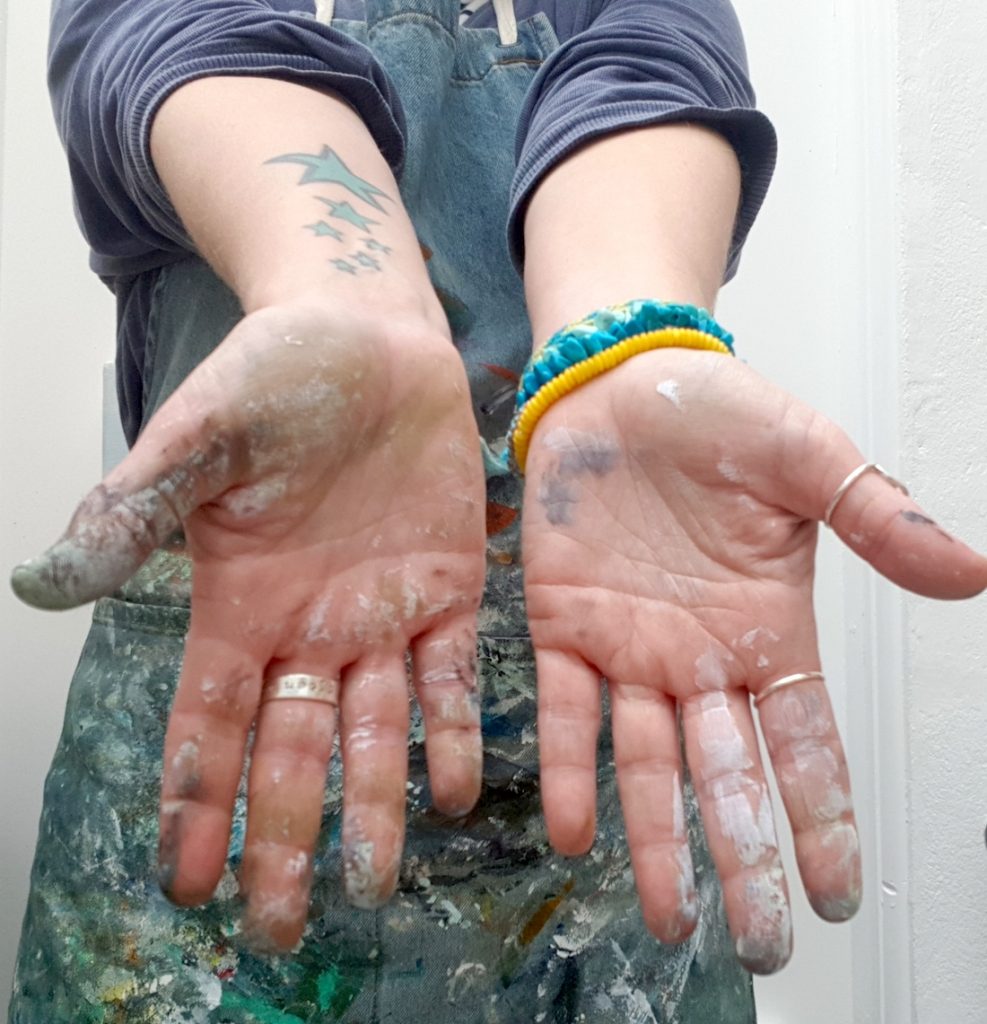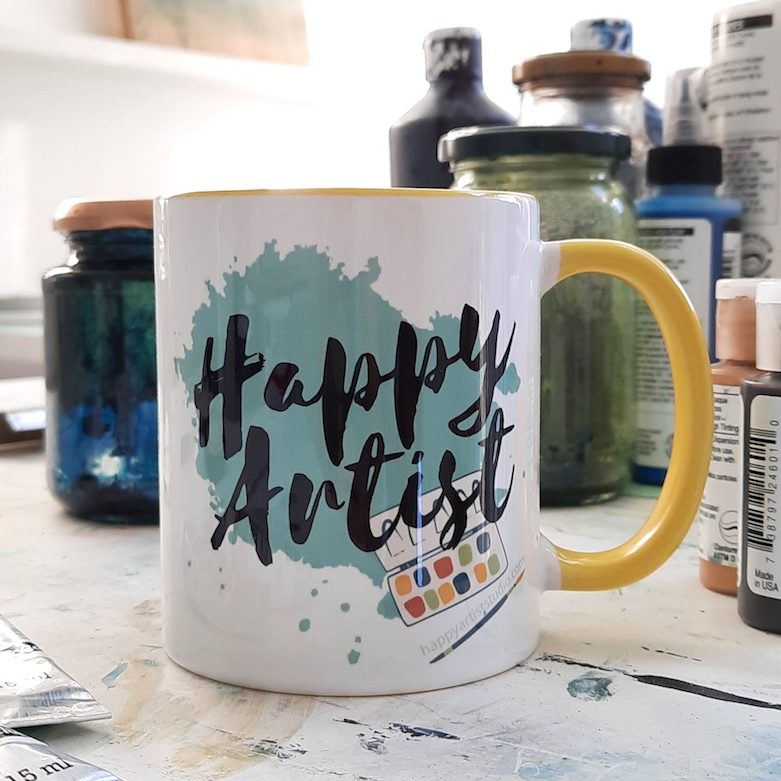Blank canvas syndrome.
It’s an actual thing. I’ve yet to meet an artist who hasn’t experienced it at some point, or at many points.
In full disclosure I don’t really get it any more, but that’s a good thing because
a} it means I’ve tried lots of ways to get past it that I can share with you and
b} they worked.
So it’s not one of those things you have to have forever.
I’ve had this post hanging around in my drafts for well over a year, and since someone recently mentioned that they’d find a list of ways to get past fear of the blank canvas quite useful, {thanks Lisa!}, I thought, let’s get this puppy out and see what we’ve got.
So behold.
Twelve things you can do with a blank canvas so it’s no longer a scary looking expanse of white and both you and it are ready for all the good things you’re going to put on it.
I’ve even made a little PDF you can print out and put next to your easel or in your sketchbook in case of emergencies.
Actually, before I begin, I just want to point to the WHY here.
Generally speaking as adults, we are afraid to make mistakes.
We are terrified of being ‘wrong’, of humiliating ourselves or somehow proving we are ‘less than’.
It’s something education and culture, and sometimes upbringing, unkind or unaware teachers, have often drummed into us.
So it can feel unsafe standing in front of a white page or canvas because there is potential to mess it up.
That is O.K. It’s just an old story and not one we have to keep.
We can rewrite it just by making some marks. If a canvas feels too much, start with a sketchbook. If that feels too much, start with a single sheet. Use inexpensive supplies at first. Do whatever you need to feel safe enough to begin.
And then begin. Even if you don’t feel 100% comfortable. You can do it. 😊
1. Paint the whole thing a single colour
Maybe the easiest and most mindless: cover the entire canvas with a ‘ground’, as it’s known in the business, and there – no more white space staring at you.
This also makes for richer colours when you paint over it, and you can even leave bits peeping through.
2. Pick 2 or 3 colours and doodle
Since whatever you do first will most likely be covered up by the end, it doesn’t actually matter what goes down first. So let rip!
Limit your colours if that feels more comfortable, pick a large and a small brush for variation {a good thing to ingrain into your habits}, and wiggle and smear lines and blobs all over it. Use both hands and see how that can help vary marks too.
3. Finger painting
Pretty self explanatory. Fingers, paint, go.

4. Collage
Bypass using paint for a bit and stick some things down. {You can add paint too!}
My personal favourite is textured wallpaper samples and purposely crumpled tissue paper because they pick up the paint in interesting ways.
Experiment with types and textures of paper, lace, found objects or fabric.
5. Throw paint at it
Channel Jackson Pollock, lay it on the floor {this works best for larger canvases and obviously protect the surrounding area or do it outside} mix some paints in generous amounts with a little water for a loose consistency {or use fluid acrylics or poster paints} and ‘throw’ the paint down with your hands or a brush.
If you’re using fluid acrylics or poster paint try squeezing it straight from the bottle. Play with wiggling it about from different heights and angles, flicking it, dripping and pouring. This video gives an excellent demonstration. 😉
6. Stamp on it
Not with your feet. Although you could, especially if they had paint on them. Yves Klein liked to get paint covered female models to roll about naked on his canvases, which is certainly one way to cover them.
If you have one or several stamps and some inks, stamp all over it until it’s covered enough to start painting. Best for, but not exclusive to, sketchbooks or art journals because of size and surface solidity.
Another thing is to use stencils. {Especially fun with spray paint.}
7. Close your eyes
This has the double benefit of making it almost impossible to do something ‘good’, which often tends to mean ‘accurate’ and then becomes limiting, and making you more aware of the sensuality of painting.
It’s not just about the visuals. There is texture, the feel of paint under your hands or brush, and sound. Put music on and let it guide your hands while your eyes are closed.
8. Blind contour drawing
A good one to use for the same reasons as closing your eyes.
Pick a subject, something as simple as a jug or as complex as a vase of flowers, put your pen, charcoal, pastel or pencil down on the paper or canvas, and let your eyes tell your hand where to go.
Follow the lines and shapes slowly, looking only at your subject. No peeking. It won’t look much, if at all, like the thing you’re drawing and that’s good.
You might even be pleasantly surprised and want to develop it further into a part of the painting. Click here for a video demo.
Related post: 4 ways with blind contour drawing {and 12 reasons to love it!}
9. Scribble
Best for paper, can also work on canvas if you use a brush and a generous amount of paint.
Cathartic for a bad mood without needing to break anything {ripped paper doesn’t matter}.
If you have doubts about scribbling as an art form, take a look at Cy Twombly‘s work.
10. Drips
Blob paint generously along the top of the canvas or page, spray with water or just keep adding a brush dipped in water and tip it to help it run. One direction or many. One colour or several. Make blobs further down and keep letting it drip.
My favourite thing about drips in acrylics is that if you do them over another {dried} layer of colour and then gently pat them with a rag when almost dry, it creates lovely rivulets with the underneath colour showing through.
11. Write on it
One word over and over, a story, a rant, a prayer, a poem, all the swear words you know, all your favourite words, anything you want. No one will ever see it.
In fact if you make it a real mess, it’ll be even easier to cover it up with paint asap, just to get rid of the eyesore.
12. Doodle
A gentler version of scribbling, possibly best for smaller canvases and sketchbooks/journals, although don’t let that become a rule.
Take something that makes a mark – even better if it’s in a colour you love or a texture you enjoy – and take your line for a walk, as Paul Klee would say.
>>Click here<< for the PDF
Some of these are better for sketchbooks and art journals, some more conducive to larger canvases. Combine ideas and invent new ways. The more playful and fun you can make it, the easier it becomes.
Another great side effect of all this is that it starts to get you used to expressing with a greater amount of freedom, which in turn leads to greater confidence and accumulated knowledge and skills.
Now go forth and mess up some canvases!
This list is not exhaustive; what do you do to get past Blank Canvas Syndrome? Please add your ideas to the mix below!
PS. If you like these idea but still have some fear going on, read this.








I have been having fun with watered down acrylics – choosing about 3 colours, pouring them on my plywood boards (also used some wood blocks last week, but bigger is better) and moving the paint around. Can get very messy, but it is very fun – and my son thinks it looks cool. I also rarely have a blank “canvas” now, as I wipe off my brushes on blank plywood boards, and then use those boards later to start a new painting. Thanks for all your sharing, you are a generous soul.
Oh that sounds lovely – watered down acrylics on wood! I can imagine that’s gorgeous. I wipe off my brushes too – can’t believe I forgot about using up left over paint to start a new canvas or sheet of paper! Thanks for adding to the list!
Oooh poured watered down paint, that sounds like Helen Frankenthaler ????
I have done all of these plus a few more variations with randomly picking colors in paint, pencils, runny drips, drops, starting with a canvas pad or canvas with a few stains, smearing paint with a palate knife, take a monotype standing on paper then rub from another wet painting, etc. For songwriting and writing to start the blank page I use freewriting, picking words randomly from books or overheard conversations, prompts help. Basically any randomness to get started
So many great ideas here Andy! Thanks for sharing. 🙂
Wish I’d seen this 20 years ago, but I’ve seen it now! Great thoughts ! Love what everyone has said. Thank you very much, Jan
Yay! Never too late to give them a go. 🙂
Looking forward to xperience some great artistic moments!!!!
Excellent!